Après des années de création de sites WordPress, nous avons appris à quel point il est important d’avoir une installation locale de WordPress sur votre ordinateur.
Avoir WordPress sur votre machine personnelle vous permet d’expérimenter de nouvelles fonctionnalités sans risquer votre site en direct, de plonger profondément dans le développement de WordPress, et même de construire des sites entiers avant qu’ils ne soient mis en direct. C’est comme si vous aviez un bac à sable privé pour tous vos projets WordPress.
Si vous êtes un utilisateur de Windows, il existe de nombreuses façons d’installer WordPress localement. Mais nous avons réduit la liste aux deux méthodes les plus simples. Dans ce guide, nous vous montrerons comment installer facilement WordPress sur un ordinateur Windows, quelle que soit la version que vous utilisez.
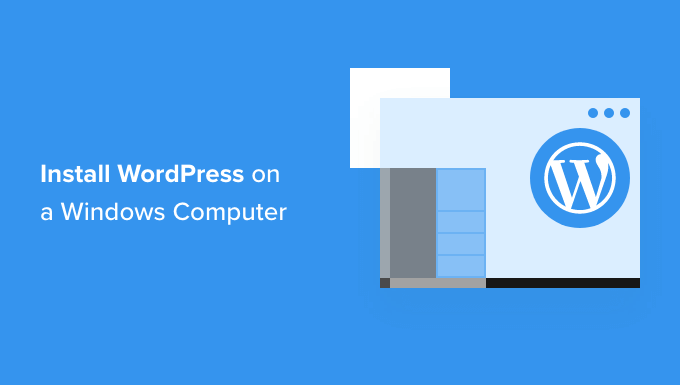
Pourquoi installer WordPress sous Windows ?
Si vous utilisez Windows, l’installation locale de WordPress sur votre ordinateur présente plusieurs avantages.
Une installation locale de WordPress crée un environnement de test qui n’affecte pas votre site direct. Cette installation, souvent appelée serveur local, est votre terrain de jeu personnel pour WordPress.
Les développeurs WordPress utilisent régulièrement des installations locales pour leur travail. Par exemple, ils peuvent s’en servir pour expérimenter de nouvelles extensions ou de nouveaux thèmes, ou pour tester le site avant la mise à jour vers l’éditeur de blocs Gutenberg.
Mais ce n’est pas seulement pour les professionnels. Si vous êtes nouveau sur WordPress, une installation locale est parfaite pour apprendre. Vous pouvez explorer les fonctionnalités, tester les thèmes et les extensions, et expérimenter librement sans craindre de casser un site en direct.
Il est important de noter que lorsque vous installez WordPress localement sous Windows, vous êtes le seul à pouvoir voir le site. Si vous souhaitez créer un site public, vous aurez besoin d’un nom de domaine et d’un hébergement.
Techniquement, il est possible d’installer WordPress sur Windows en utilisant XAMPP, et nous avons déjà écrit un tutoriel à ce sujet.
Cela dit, nous avons trouvé deux méthodes encore plus simples que XAMPP pour mettre en place un environnement WordPress local, ce qui les rend parfaites pour les débutants ou les utilisateurs qui ont besoin de créer un site local rapidement. Vous pouvez cliquer sur le lien ci-dessous pour passer à la méthode qui vous intéresse :
Méthode 1 : Installer WordPress sur Windows à l’aide de Studio (rapide et simple)
Pour la première méthode, nous utiliserons Studio. Il s’agit d’un logiciel WordPress local conçu par Automattic, la société qui gère et exploite WordPress.com, qui est un constructeur de sites web basé sur le logiciel WordPress.
Nous parlerons d’abord de cette méthode parce qu’elle est beaucoup plus rapide et plus simple à suivre, ce qui la rend idéale pour les débutants complets.
Tout d’abord, vous devez ouvrir le site Studio by WordPress.com. Ensuite, cliquez sur le bouton “Télécharger pour Windows”.

Une fois cela fait, il suffit d’ouvrir le fichier téléchargé pour lancer l’installation.
Une fenêtre contextuelle apparaît alors, vous indiquant que l’application est en cours d’installation.
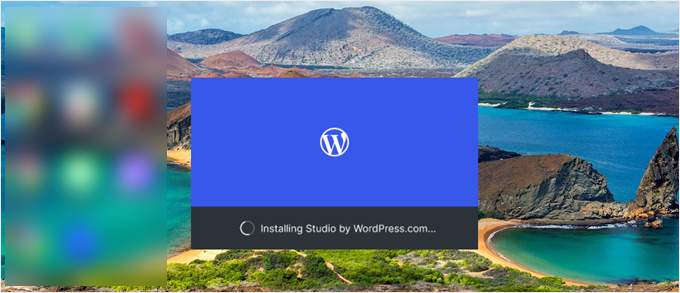
Ceci fait, vous pouvez ajouter votre premier site.
Pour ce faire, il vous suffit de saisir le nom de votre nouveau site WordPress local et de cliquer sur “Ajouter un site”. Vous pouvez nommer le site comme vous le souhaitez, tant qu’il vous permet de l’identifier facilement.
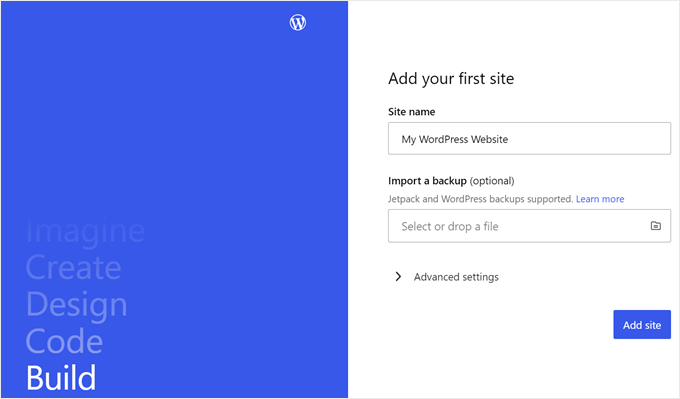
Vous devriez maintenant voir le tableau de bord de votre site WordPress local.
Pour accéder à votre tableau de bord WordPress et modifier votre site, il vous suffit de cliquer sur le bouton ” Démarrer ” en haut à droite. Vous pourrez ainsi accéder à votre site local sur votre ordinateur.
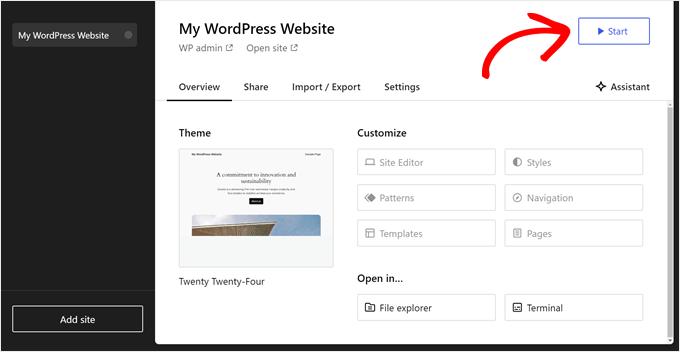
Une fois que le bouton “Start” est modifié en “Running”, vous pouvez cliquer sur le lien “WP Admin” en haut à gauche de la page.
Cela vous amènera à la page d’administration locale de WordPress.

Et c’est à peu près tout pour la configuration. Explorons les autres paramètres qui peuvent s’avérer nécessaires au fur et à mesure que vous construisez votre site local.
Comme vous pouvez le voir dans l’onglet ‘Overview’, vous pouvez immédiatement accéder au menu de l ‘éditeur WordPress full-site directement depuis le tableau de bord de Studio. Vous pouvez également cliquer sur ‘File explorer’ pour ouvrir les dossiers et les fichiers de votre site WordPress et cliquer sur ‘Terminal’ pour gérer votre site à l’aide de WP-CLI.
Si vous passez à l’onglet “Partager”, vous pouvez vous connecter à votre compte WordPress.com, cloner votre site local et le téléverser sur les serveurs de WordPress.com. Cela rendra temporairement le site cloné en ligne, ce qui est utile pour partager des sites de démonstration avec vos clients ou les membres de votre équipe.
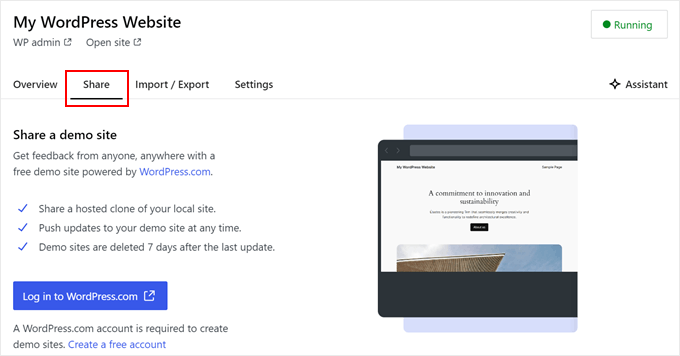
Il peut arriver que vous souhaitiez vous connecter à votre site local directement via votre navigateur au lieu d’utiliser Studio. Dans ce cas, vous devez connaître vos identifiants wp-admin.
Pour les trouver, vous pouvez passer à l’onglet “Réglages” et y trouver votre nom d’utilisateur, votre mot de passe et votre URL de connexion pour l’administration de WordPress.
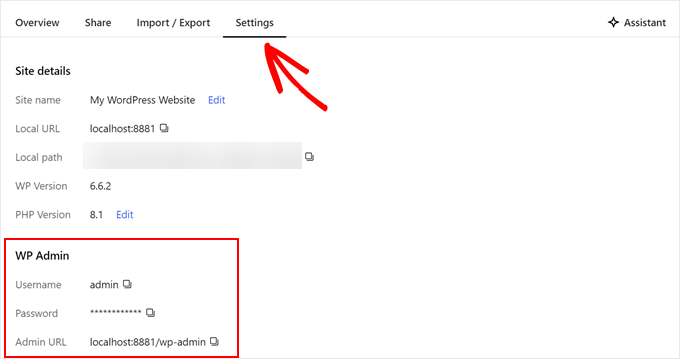
Une autre fonctionnalité intéressante de Studio est son chatbot IA intégré, avec lequel vous pouvez communiquer en cliquant sur le bouton “Assistant”.
Ici, vous pouvez demander de l’aide à Studio pour des tâches telles que la mise à jour de toutes vos extensions en une seule fois, la mise à jour de votre version principale de WordPress ou la création de code pour un bloc personnalisé.

Lorsque vous avez fini de travailler sur votre site local, survolez le bouton “En cours d’exécution” dans le coin supérieur droit jusqu’à ce qu’il indique “Arrêter”.
Cliquez ensuite sur le bouton pour arrêter le site.

L’inconvénient de Studio est que vous ne pouvez pas configurer l’environnement WordPress à votre guise. Cela signifie que vous devez utiliser la version PHP, le serveur web et la base de données qui ont été présélectionnés pour vous.
Cela peut être un inconvénient si vous devez tester votre site ou votre extension avec des configurations de serveur spécifiques.
Si vous avez besoin de plus de contrôle sur votre environnement WordPress local ou de faire correspondre votre configuration locale avec une configuration de serveur live spécifique, alors vous pouvez consulter la méthode suivante en utilisant Local WP.
Méthode 2 : Installer WordPress sur Windows en utilisant Local WP (plus personnalisable)
Tout d’abord, vous devez télécharger et installer le logiciel Local WP sur votre ordinateur Windows. Il vous suffit de vous rendre sur le site de Local WP et de cliquer sur le bouton “Télécharger gratuitement”.
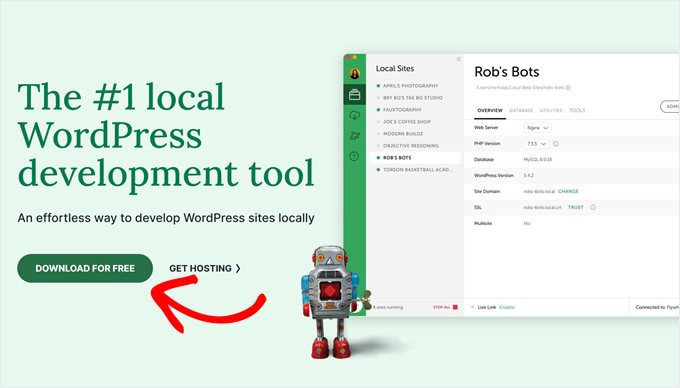
Après cela, une fenêtre popup apparaîtra où vous devrez sélectionner votre plateforme. Choisissez “Windows” dans le menu déroulant.
Ensuite, vous pouvez saisir vos coordonnées telles que vos nom et prénom, votre adresse e-mail professionnelle et votre numéro de téléphone pour télécharger le logiciel.

Après avoir saisi/saisie les détails, il suffit de cliquer sur le bouton “Get it Now”.
Ensuite, le logiciel sera automatiquement téléchargé sur votre ordinateur. Sinon, vous pouvez cliquer sur le lien “cliquez ici” pour lancer le téléchargement.

Une fois le fichier téléchargé, lancez l’assistant de configuration.
Vous devez maintenant sélectionner si vous souhaitez installer le logiciel pour tous les utilisateurs ou seulement pour vous.
Une fois que vous avez sélectionné une option, cliquez sur le bouton “Suivant”.
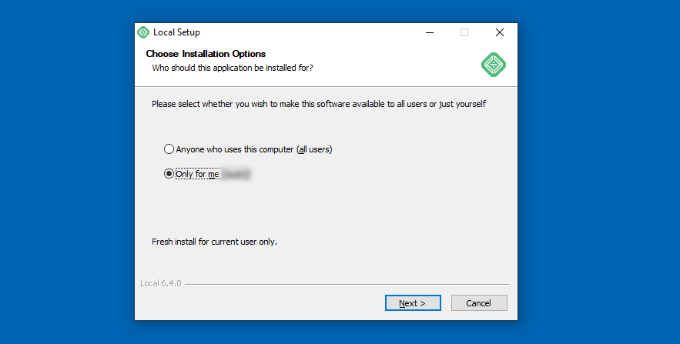
À l’étape suivante, vous pouvez sélectionner le “Dossier de destination” dans lequel le logiciel sera installé.
Il suffit de cliquer sur le bouton “Parcourir” pour définir le chemin d’accès, puis de cliquer sur le bouton “Installer”.
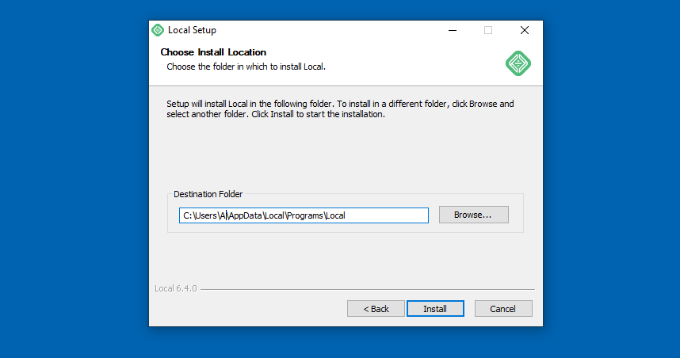
Le logiciel Local WP va maintenant s’installer sur votre ordinateur Windows.
Une fois que c’est fait, vous pouvez cocher la case “Exécuter localement” et cliquer sur le bouton “Terminer” de l’assistant de configuration.
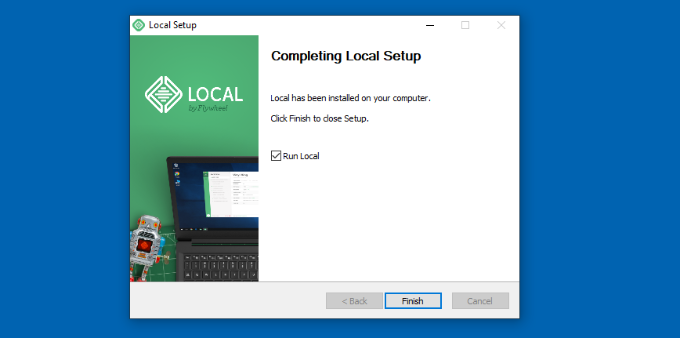
Le logiciel est maintenant lancé sur votre appareil Windows.
L’étape suivante consiste à ajouter un nouveau site local. Pour ce faire, il suffit de cliquer sur le bouton “+” en bas de la page.
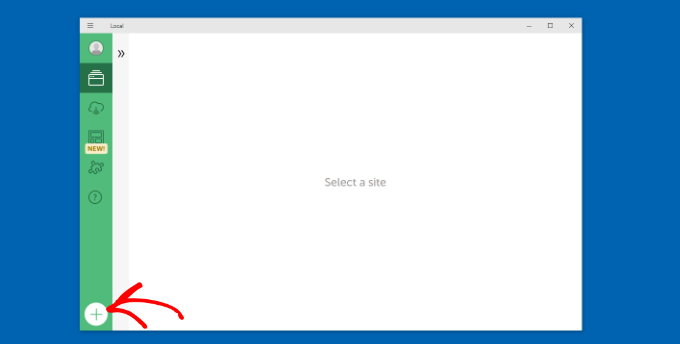
Ensuite, vous pouvez créer un site dans le logiciel local.
Sélectionnez l’option “Créer un nouveau site” et cliquez sur le bouton “Continuer”. Il est également possible de créer le site à partir d’un plan ou d’un fichier de site web existant, mais nous choisirons la première option pour les besoins de la démonstration.

Ensuite, vous pouvez saisir un nom pour votre site local, par exemple “Mon site WordPress”.
Il existe également des options avancées qui vous permettent de saisir le domaine et le chemin d’accès du site local. Par défaut, le domaine utilisera le titre de votre site, mais séparé par des tirets.
Une fois que vous avez terminé, cliquez simplement sur le bouton “Continuer”.

Ensuite, vous devrez choisir un environnement pour votre site local.
Vous pouvez utiliser l’environnement “Préféré” dans lequel le logiciel sélectionnera automatiquement la version PHP, le serveur web et la version MySQL. D’autre part, vous pouvez également sélectionner “Personnalisé” et saisir les détails de l’environnement.
Local WP propose les dernières versions de PHP. En ce qui concerne le serveur web, vous avez le choix entre NGINX et Apache. Vous pouvez également sélectionner MySQL ou MariaDB pour les bases de données.
Notez que certaines versions de PHP, de serveurs web et de bases de données nécessitent le téléchargement de certaines dépendances pour fonctionner correctement.
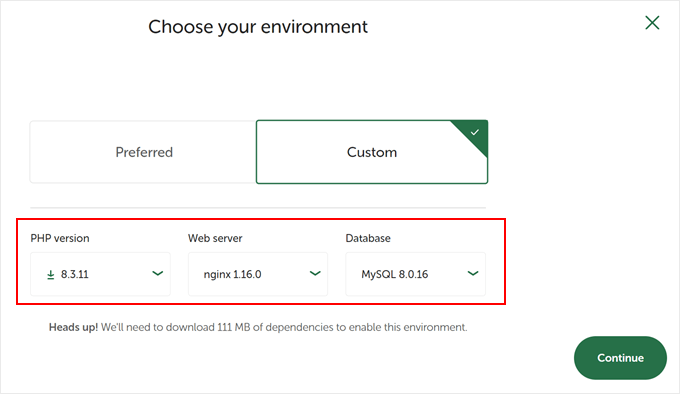
Ensuite, vous pouvez saisir un nom d’utilisateur et un mot de passe WordPress pour votre site local. Il est également possible de choisir une adresse e-mail WordPress à laquelle vous recevrez toutes les notifications par e-mail.
À part cela, il y a une option avancée où le logiciel vous demandera si vous avez un réseau multisite WordPress. Si ce n’est pas le cas, cliquez simplement sur “Non”.
Après avoir saisi/saisie ces informations, il suffit de cliquer sur le bouton “Ajouter un site”.
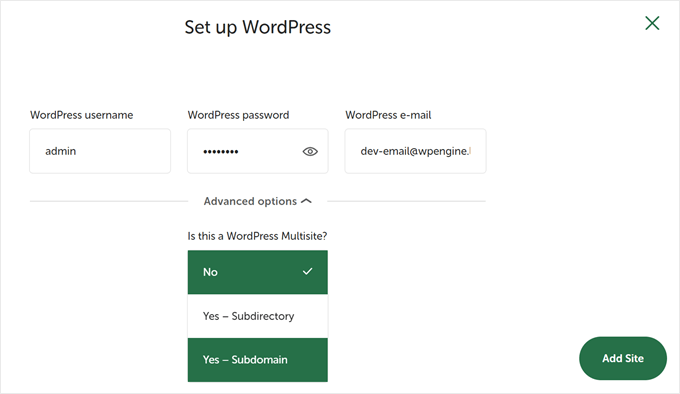
Le logiciel va maintenant installer WordPress et configurer votre site.
Pour lancer le site local, cliquez sur le bouton “Démarrer le site” en haut à droite.
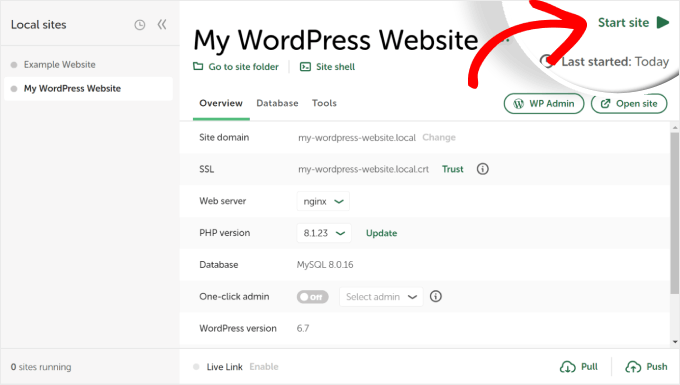
Ensuite, cliquez sur le bouton “WP Admin”, et vous verrez la page de connexion à l’administration de WordPress.
Il suffit de saisir le nom d’utilisateur et le mot de passe que vous avez saisis lors de la configuration du site local, puis de cliquer sur le bouton “Se connecter”.

Vous pouvez maintenant modifier votre site local sur votre ordinateur Windows.
Lorsque vous avez terminé, n’oubliez pas d’arrêter le site à partir du logiciel Local WP en cliquant sur le bouton ‘Arrêter le site’.
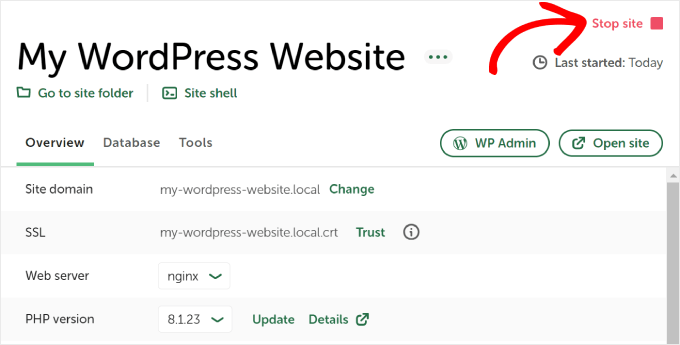
Astuce : Si vous voulez sauter le processus de connexion, vous pouvez activer une connexion d’administration en un clic dans Local WP.
Pour ce faire, il suffit de retourner dans le tableau de bord local de WP et de faire basculer le bouton ” One-click admin ” jusqu’à ce qu’il indique ” On “. Ensuite, dans le menu déroulant, sélectionnez l’utilisateur administrateur qui peut utiliser cette fonctionnalité de connexion en un clic.

Alternative : Utiliser WordPress Playground pour tester des thèmes, des extensions et plus encore
WordPress Playground est un outil innovant qui vous permet d’expérimenter avec WordPress directement dans votre navigateur web. Il s’agit d’un bac à sable virtuel où vous pouvez essayer de nouveaux thèmes, extensions et fonctionnalités WordPress sans affecter un site réel.
Le terrain de jeu WordPress diffère d’un environnement WordPress local à plusieurs égards.
Tout d’abord, il ne nécessite pas d’installation sur votre ordinateur et se réinitialise après chaque utilisation, contrairement aux installations locales permanentes. Vous pouvez y accéder depuis n’importe quel appareil doté d’un navigateur, alors que les installations locales sont liées à un ordinateur.
Alors que WordPress Playground est idéal pour les tests rapides et l’apprentissage, un environnement WordPress local sur votre ordinateur Windows offre plus de flexibilité pour les projets de développement à long terme.
Pour une description détaillée, consultez notre guide sur l ‘utilisation de WordPress Playground dans votre navigateur.
J’ai installé WordPress sur mon ordinateur Windows, que faire maintenant ?
Maintenant que vous avez installé WordPress sur votre ordinateur, voici ce que vous pouvez faire :
- Apprenez les trucs et astuces de base de WordPress pour mieux utiliser votre site.
- Essayez différents thèmes WordPress pour voir à quoi votre site peut ressembler.
- Installez et testez les extensions WordPress indispensables pour ajouter de nouvelles fonctionnalités à votre site.
- Apprenez à corriger les erreurs courantes de WordPress par vous-même.
- Essayez différents constructeurs de pages par glisser-déposer pour rendre votre site attrayant.
- Découvrez comment réinitialiser le mot de passe administrateur de WordPress sur localhost pour récupérer l’accès à votre site.
- Mettezen place des flux de travail automatisés pour faciliter la gestion de votre site.
- Apprenez à connaître la sécurité de WordPress pour protéger votre site des pirates informatiques.
- Déplacez votre site WordPress local vers un serveur live lorsque vous êtes prêt à le partager avec tout le monde.
Nous espérons que cet article vous a aidé à apprendre comment installer WordPress localement sur un ordinateur Windows. Vous pouvez également consulter notre article sur la façon d’installer WordPress localement sur un ordinateur Mac et notre guide ultime pour créer un site de mise en scène WordPress.
Si vous avez aimé cet article, veuillez alors vous abonner à notre chaîne YouTube pour obtenir des tutoriels vidéo sur WordPress. Vous pouvez également nous trouver sur Twitter et Facebook.





Bidyut Kumar Mondal
Thanks a lot for such a wonderful post.
Ali
Just to say Thank you very much.
sreenu
thank you…thank you soooooooooooo much ..
Nissim
Thank you so much. this was sterling
adriana
OMG i made it through. lol. thank you for your time writing this, it helped me through the panic stage lol
mahendra
Who help of peoples, They are God
Kenneth Ekeh
Help please! I have followed the article and installed wamp, created the wp database but culd not be able to run complete configuration of wp. Its telling me “can’t select database”. Try Again. Please help me to fix this. Thanks.
WPBeginner Support
During the installation when it asks for your database details, please make sure that you are entering the same name for the database which you used when creating database in phpmyadmin. For username, use root and leave password blank.
Admin
Tom
Upon opening mysql workbench, choose your connection, then write the code without quotes “create database nameofyourdatabase;” this will be the name of your database and what you will use in the wordpress setup when it asks for the name of your 1)database(use nameofyourdatabase) 2)username 3)password 4)database host(im using “localhost”)
Hope this helps.
Tammi L. Coles
Just a quick note of thanks for this very simple-to-follow tutorial. It worked like a charm (including the Apache rewrite for permalinks follow-up).
ogunmakinwa dayohanks.
Your tutorials as been good for me so far, but please which stable wordpress can i download? can i download the latest version? i am just thinking that some plugins might not be available for the latest version.. so for now which version do you recommend for me? thanks
WPBeginner Support
We always recommend using the latest stable version of WordPress.
Admin
Mohamed Ishag
Hi there,
Would you please answer the question posted on 12/11/13 I still need help
as I am unable to run the WAMP Server on Windos 8. Please read question posted on 12/11/13.
Thank you in advance.
Regards,
Mohamed
Orestes
I was able to install WP, but I’d like to know how to manage different web logs within my local server. Thank you for the instructions and tutorials here.
WPBeginner Support
you can install different weblogs (blogs or websites) on the same server by installing wordpress in different sub-directories inside your
/wamp/wwwfolder. For example:C:\wamp\www\site-1 will open in http://localhost/site-1
C:\wamp\www\site-2 will open in http://localhost/site-2
Admin
GinoDC
After entering details for Site Title, Username, Password and Email I press Install WordPress and my computer hangs. Please help.
WPBeginner Support
This could happen for a number of reasons. Try to uninstall wampserver and then download and reinstall again. If the problem presists, then you can try XAMPP.
Admin
Mohamed Ishag
Hello,
I have installed WAMP on Windows 8 but I am having a problem creating a data base due to the following error (You don’t have permission to access /phpmyadmin/ on this server). I have edited the htpd.conf file as follows
Open file httpd.conf through wamp tray icon
Find:
# onlineoffline tag – don’t remove
Order Deny,Allow
Deny from all
Allow from 127.0.0.1
Change to:
# onlineoffline tag – don’t remove
Order Deny,Allow
Allow from all
Then saved but still get the same error, why!? Norton 360 is installed on the PC
and no other conflicting apps. I need some help to fix this issue. Any ideas? Thank you in advance.
Best Regards,
Mohamed
Mohamed Ishag
Dear Syed and the team,
Thank you very much for this site. I am new to WordPress and found your tutorials and explanation very good and straight forward. I feel that you are a busy man but still have time to dedicate this site to new WP beginners. God bless your parents.
Salam,
Mohamed
adam
Hello,
I have installed everything and am finally at my wordpress dashboard on my localhost machine. everytime i click on visit my site to view what I have changed the page simple directs to the WAMP server configuration screen that shows apache version, php version, loaded extensions, etc… It seems that something simple needs to be changed but I dont know…Can anyone please help? Thanks in advance…
WPBeginner Support
You have probably installed WordPress in www directory. You need to install it in a subdirectory like www/testsite1/
Admin
Nuno
Hey i have the same problem, so if i just copy all the files to a subdirectory it will work or do i have to reinstall it all over? Thanks.
Matthew
Thank you, than you, thank you. I am a technophobe and your clear instructions helped me all the way.
Arthur
Hi,
After installing WAMP in accordance with your instructions, I could not open phpmyadmin; explorer kept waiting for localhost. I’m not a pc techie so I desperately need instructions how to proceed furter in the same easy way as your manual above. I have a 64 bit W7 machine, and installed the 64 bit version of WAMP first, but since that did not work as described , I installed the 32 bit, but with the same result. Thanks for your help in advance ! (No Skype, port 80 OK, as far as I can see)
WPBeginner Support
Try restarting all services make sure that WAMPServer icon is green also make sure that Skype is not running in the background. Also look at this support thread for more possible solutions.
Admin
Arthur
Thanks a lot: I followed your recommended thread and I removed a double line in the Host file (‘127.0.0.1 Localhost’) that seemed too much and now I can get to a log-in page of phpMyAdmin, which is great, but I have not yet even entered an ID and password during initial installation of WAMP. Did I miss something ?
Thanks for your patience again…
WPBeginner Support
To log in to phpMyAdmin, enter username root and leave password blank.
Trudy Ritsema
Can I run more than 1 test site on WAMP? and any ideas of how I would go about this please?
I already I have localhost site running – and I don’t want to get rid of that yet as I am still developing it…
Thanks in advance.
WPBeginner Support
in your www directory create new directories for each website. That way you can run multiple sites on localhost.
Admin
viki
i can’t create new database, bcause it is showing ” * No Privileges” in red colour letters. please help me
WPBeginner Support
you are probably entering wrong credentials to connect to your mysql database.
Admin
nick mav
you should login using the following credentials:
username: root
password: [empty] –> that is, no password
Shawn Morrissey
Thanks Nick,
I had the same issue and couldn’t find this out anywhere I had looked previously…
SanketP
Hi. I am a new-bee to this world of eb designing. Wanted Joomla but that didnot go thru too well. WP instal was as good for me. Thank you. XOXOXO.
Everett
Hello. I want to be able to develop my wordpress site locally and not have to be connected to the web when I make changes and do save or update inside wordpress. Before I go through all the installation of WAMP and WP locally, can anyone tell me if I will have to have internet access to make updates to a wordpress running locally in WAMP? Sure I realize if I wanted a new Theme or Plugin, I would have to be online, but if I am just making adjustments to text and adding pictures that are already on my laptop, etc. will I have to have internet access to do so? I ask because I do a lot of travel where I am on an airplane and could be working on a new version of a website if I don’t have to be online. Also, I can’t afford a wireless account for my laptop, so I only have internet when I am at home with my own wifi or when I am somewhere that has a free wifi. Thanks.
WPBeginner Support
no you do not need an internet connection to work locally on your website.
Admin
Ian
I followed the instructions to the letter, installed WAMP and the required SP1 Visual C++ on a brand new laptop running Windows 8 64bit. The installation refuses to launch, brings up a screen asking if I’m sure I want to let this programme make changes to the computer, then does nothing when ‘Yes’ is clicked. What is going wrong?
WPBeginner Support
Does the wampserver icon appear in your windows taskbar? If it does, then you need to click it and launch wampserver.
Admin
Brynn
Please help. I installed WAMP but when I went to open phphMyAdmin, nothing happens. I tried uninstalling and reinstalling, but still getting the same problem. I’m not even getting any sort of popup block notification in my browser. Just nothing.
I wonder if this might have something to do with the WARNING window that popped up on the WAMP website before I downloaded it… It said something in French, and then something about needing to install C++ which I know nothing about, and which was not mentioned in this tutorial.
Do I need to install C++ and if so, do I need to learn how to use the programming language before I can finish this tutorial on installing WordPress? I am a designer, not a programmer, so I hope to god I don’t need to stop everything and go learn C++ before I can do a simple WordPress install.
WPBeginner Support
Brynn you can always check whether or not Microsoft Visual C++ is installed on your computer from Control Panel -> Programs and Features. Do you see wampserver page when you visit http://localhost? If you do, then you have already successfully installed WAMP.
John Victor
Can I hug you now or later?
Anudeep
Awesome tutorial
guru
I install wordpress to my localhost. But i dont know to use it to develop a site. I’m new to wordpress. Please anyone help me.
WPBeginner Support
Take a look at our beginner’s guide section. For theme development you may want to take a look at our WordPress theme cheat sheet for beginners.
Admin
Scott Cho
Got WAMP installed, but when I try to create a new databse by clicking on the phpMyAdmin button in WAMP the chrome browser window that opens up says:
Forbidden
You don’t have permission to access /phpmyadmin/ on this server.
Can anyone point me in the right direction as to what this is and how to fix it? I don’t know if this makes a difference but I have it installed on my secondary hard drive, not my C drive (the c drive just has my operating system).
Asad Riaz
Here is how you edit the htpd.conf file
Open file httpd.conf through wamp tray icon
Find:
# onlineoffline tag – don’t remove
Order Deny,Allow
Deny from all
Allow from 127.0.0.1
Change to:
# onlineoffline tag – don’t remove
Order Deny,Allow
Allow from all
Plus resolution to some other conflicts
Make sure no other program conflict wamp such as Xampp, phpEasy, IIS, Skype, Zonealarm, firewall/antivirus, NOD32, Eset, any web and/or Remote Desktop related program, such as Teamviewer …
IIS and Apache/Wamp are both web server and might conflict in some way, so you have to disable IIS in order for Wamp to work
Disable IIS in Vista/W7:
Control Panel, Uninstall Programs, Turn Widows Features On or Off, uncheck Internet Information Services
Disable IIS in XP:
Control Panel, Add/Remove Programs, Add/Remove Windows Components, uncheck Internet Information Services (IIS)
Restart computer, then restart Wamp
Also, in folder C:\WINDOWS\System32\drivers\etc, open file hosts and delete anything in this file and have only this line below and nothing else
127.0.0.1 localhost
If using Skype, go to Tools->Options->Advanced->Connection and uncheck the box “Use 80 and 443 as alternatives for incoming connections”. Restart Skype after WAMP. Now you will be able to use both programs at the same time w/o problems.
I hope it helps, found it on net
Asad Riaz
Howdy,
Well i have managed to install it using the article. Some info was missing in this article like
1. Once you click on phpMyAdmin, it asks for login details, so here they are:
username: root
pass: (leave it blank)
2. WAMP sometimes gets offline and it wont open the phpMyAdmin page, so you guys need to edit the htpd.conf file in C:wamp/bin/apache4.2/conf/htpd
Lets see now how much it helps me.
I m here for all the support that i can extend.
Thanks to the author of this page.
Cesar M.
thanks for the user info I was getting crazy, but I finally got in to phpmyadmin
Colin Teasdale
Hiya,
Problem solved – I had needed to install the Visual C# redistributable, and did that after installing Winamp. Uninstalled Winamp, rebooted and then re-installed – everything fine. That’ll be user error then ! ! !
Colin T.
Scott Cho
I’m getting the same error you just described below, where is this redistributable you speak of?
Colin Teasdale
Hi guys,
I’ve just downloaded and installed WAMP and have got to the “set up a database” stage. When I select ‘phpMyAdmin’ I get a ‘Firefox Problem Loading Page’ page with “Unable to connect – Firefox can’t establish a connection to the server at localhost”.
I’ve tried the fix suggested by Imran on June 17th, but this doesn’t seem to have fixed resolved the problem.
Any thoughts on how I fix this, please??
Peter
Hi Editorial Staff,
Do you have a tutorial that is the reverse process also using WAMP? I have a functioning website that I would like to duplicate on my home computer for experimenting and learning css, and php programming without risking my functional website.
Thanks.
EL
That is exactly what I need!
Denzil
Hi, a very useful article, thanks. Is it easy to migrate a test WP site on WAMP to a hosted site elsewhere? Do you have a tutorial article to help?
Thanks
Editorial Staff
Yes, it is fairly easy to do that. Tutorial will be coming tomorrow
Admin
Denzil
Great! How timely! Thanks guys, looking forward to it.
Kate BP
Absolutely cracking article – really helpful, thanks so much!
akash
After clicking on phpmyadmin,,,,,,,
i am getting redirected to directly php my admin webpage and not the database entry option which is shown above.
thereafter the details are not matching afterwards in database,username and password.please give me its solution as soon as psbl.
Amitoj Gautam
User Name: Root
Password: None (Leave this space empty)
Click on the Go button. You will be directed to the page you are looking for.
Dana
Hi! Once I’ve created a site on my WAMP server, could I then transfer it to an existing domain name? I’m trying to create a new site without shutting down the old one. Once the new one is finished, I would want to replace the old one, but use the same domain name. Thank you!
Editorial Staff
Yes you can do that. We have updated the article to add a link to the tutorial.
Admin
vahid
Thank you so much
chris martin
Hi, I am having trouble with links not working. Could you help me or give me some direction on how to fix that? On my site “chrisjamesmedia.com” click menu, then “blog” and i get “not found”. This also happens with links as well.
Also, do you have a tutorial on how to host multiple domains from this as well, or point me in the right direction.? I have looked up several things about virtual domain, localhost, and everytime I find something they want me to edit httpd conf, but what they have doesnt match mine.
Thank you so much!!!!
Tamsin
Hi,
Great article, very clearly explained.
Would you be able to tell me the best way to add a second WordPress site to Wamp? I have read a lot of conflicting information and would rather not make a massive mess of things!
Editorial Staff
Create a new folder inside your www folder, then repeat this process.
Admin
Tom Smith
Hi,
Thank you for providing this excellent tutorial! It’s going to be great to get use to using WP onn my PC before I install it on my host server and create my website.
I followed your instructions and installed WAMP and then WordPress and got all the screens you showed here… and with the tweaking you suggested, I was finally able to open WP – saw the Dashboard, etc. Then I closed it.
But now I can’t seem to open WP. I open WAMP and click on Localhost – and it just sits “waiting for response from localhost” – does not open anything. I’ve tried http://localhost/my database name – it will not open – I get “HTTP 500 Internal Server Error”. Just in case, I also followed your instructions on SKYPE and unchecked that Port 80 box.
What am I missing?
Editorial Staff
Did you shut down your computer? You have to launch WAMP Server every time you restart your computer.
Admin
Imran
When i try to Setting Up a Database for WordPress, it was saying like this : Forbidden
You don’t have permission to access /phpmyadmin/ on this server. what is the reason ? can you please guide me. thank you in advance….
Editorial Staff
That’s weird. Since you are the admin of your Wamp install, then you shouldn’t get this error.
Admin
Imran
Finally i got the solution…
I think it will be useful for others.
for phpmyadmin
Goto c : wamp/alias/phpmyadmin.conf file, open with notepad.
find
Options Indexes FollowSymLinks MultiViews
AllowOverride all
Order Deny,Allow
Deny from all
Allow from 127.0.0.1
replace with
Options Indexes FollowSymLinks MultiViews
AllowOverride all
Order Deny,Allow
Allow from all
thats it…
Imran
Thank you very much EDITORIAL STAFF, this is a nice post and very usefull.
Melanie
I had this same problem with the phpmyadmin and I found and made the changes cited here to the alias file, then restarted WAMP and I was able to create my database. However, now I’m getting the same Forbidden message when I try to install WordPress on my localhost, exact text below:
Forbidden
You don’t have permission to access / on this server.
I can get to the WP install screen from 127.0.0.1, but not localhost. I’m running Windows 8. Any ideas on how to get this to install? Thanks in advance for any help you might be able to give me.
Akshay
Hi.
I wanted to use this method to test out plugins before installing then on my live site. So in your tutorial, instead of copying in clean WordPress files, I copied in a full backup of my site made using BackupBuddy.
However from this point on I’m not sure what to modify in order for my site to function correctly offline. I edited my wp-config file to the new database details, and imported my database from my online phpmyadmin to the WAMP one. However it seems like there’s something I’m missing, as when I try to access localhost/site/wp-admin I am redirected to my online login page.
Do you have any suggestions?
Thanks very much for your help.
Akshay
Brandi
I’m in the same boat – did you ever find a solutions?
Christophe R.
Another (lazy) point for XAMPP : I know there are some differences in the config files, but I use both linux (at home) and Windows (Seven and 8) at work, so I appreciate having the same interface for I only have to learn once.
Andre
Great article and easy instructions for those who want to venture into WAMPP….however, for myself, I still prefer XAMPP and do run it on it’s own on a second drive without the installable version. Updating is a breeze, although I rarely need to.
I’ve used XAMPP for many years now for both WordPress and Joomla theme development, as well for a testing server. Never had issues and I do find it quite easy to use. I used to use the full version but I found that the Lite version works extremely well.
I noticed someone said AMPPS, but I’ve never tried that…perhaps in my spare time I will try it out.
Nicholas
Its click and install that’s how easy it is and just open to localhost/ampps i use it for all my scripts that this includes as downloads and install on the service. no worries on xamp and wamp that i found to limited in some ways.
Adrian
Thanks alot it was really helpful
Thomas
Hi everyone,
I’m a very beginner with WordPress and I have created a site with it and WAMP on my computer.
Now I want to put it online, but I don’t know how to do it.
Where does a tutorial exist for that?
The thing is that I want to replace the current site, which is hosted somewhere else, and so keeping the domain name.
Does anyone know where I can find this kind of information?
Thanks a lot!
Nicholas
WAMP in the older days was great! Now there is a far more better and less embarrassing way when it comes to configuring things with WAMP. WAMP is in the past and gone for me. I use AMPPS far more better no configurations, just install and a few dips of changes in the options section that’s it. Open your browser go to your localhost and install any cms or other scripting lang within your browser using ampps. You’ll be amazed! No more downloading then extracting in www folder and then reconfiguring. WordPress is just a click and install on ampps. No hassle! Shouldn’t you guys write something about AMPPS? This is a lot more better than WAMP! WAMP lags a lot of things like cgi and stuff those are extras, but on ampps everything is included. Ever since ampps I never looked back to wamp! Sorry!
Editorial Staff
Have been using WAMP for so long that didn’t even bother with another option. AMPPS sure looks good. Good to see that it is made by the folks from Softaculous. Will have to give it a try.
Thanks for the suggestion Nicholas.
Admin
Zimbrul
Why do you say you prefer WAMP over XAMPP?
Alexander Gounder
WAMP is much simpler and easier to use compared to XAMPP.
Editorial Staff
Would second that. WAMP is easier to use. Several years ago when we used XAMPP the upgrade process was complicated and it was buggy. We switched over to WAMP and it was awesome.
Admin
Parth S.
Hi, Thank you very much for this. It’s very informative and easy to follow. However I’d suggest you mention the skype thing a lil early around the localhost point, because, there ppl start to worry when they see a blank screen with skype on in their PC.
Great post though. Keep it up.
Mladen
Just to mention, that Team Viewer also causes problems with WAMP.
Christophe R.
I actually do prefer XAMPP and DTX-Control for I can overcome security policy : Installation without administration rights (zip file pour the web server) and full access to blocked ports (80, 443, 3306).